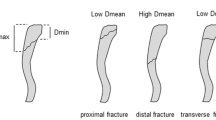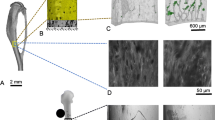Summary
This paper reviews the direct and indirect evidence for and against the idea that bone remodeling repairs fatigue damage. It defines experiments that should be performed to determine whether the accumulation and repair of fatigue damage is relevant to the pathogenesis of osteoporotic fracture. The experimental evidence favors the hypothesis that microdamage evokes local remodeling. The data suggest that the balance between the microdamage burden and bone repair is nearly constant. The indirect evidence comes from clinical observations that show positive relationships between depressed bone formation rate or prolonged remodeling period with bone fracture. More compelling indirect evidence comes from studies in which bone remodeling was pharmaceutically depressed, and fracture incidence rose in direct proportion. Data on microdamage accumulation were not collected in these studies. Conversely, some experimental evidence disputes a direct relationship between fatigue microdamage and repair. In these studies, increased amounts of bone microdamage in hyperadrenocortical dogs, and in irradiated dogs, could not be demonstrated even though bone fragility increased without associated osteopenia. Finally, the indirect evidence that argues that microdamage does not initiate repair is based on inference and does not provide an adequate test of the hypothesis. In balance, the current body of evidence favors the contention that bone remodeling repairs fatigue damage and thereby prevents fracture. Future studies should verify that microdamage accumulates when bone fracture occurs in conjunction with depressed remodeling activation frequency.
Similar content being viewed by others
References
Wainwright SA, Biggs WD, Currey JD, Gosline JM (1976) Mechanical design in organisms. Halsted Press, New York
Frost HM (1985) Bone microdamage: factors that impair its repair. In: Uhthoff HK (ed) Current concepts of bone fragility. Springer-Verlag, Berlin, pp 123–148
Frost HM (1989) Transient-steady state phenomena in microdamage physiology: a proposed algorithm for lamellar bone. Calcif Tissue Res 44:367–381
Frost HM (1991) Some ABC's of skeletal pathophysiology. 5. Microdamage physiology. Calcif Tissue Int 49:229–231
Frost HM (1963) Introduction to biomechanics. CC Thomas, Springfield, IL
Frost HM (1973) Bone modeling and skeletal modeling errors. CC Thomas, Springfield, IL
Frost HM (1981) Mechanical microdamage, bone remodeling, and osteoporosis: a review. In: DeLuca HF, Frost HM, Jee WSS, Johnston CC Jr, Parfitt AM (eds) Osteoporosis: recent advances in pathogenesis and treatment. University Park Press, Baltimore, pp 185–190
Carter DR, Hayes WC (1977) Compact bone fatigue damage: a microscopic examination. Clin Orthop Rel Res 127:265–274
Carter DR, Caler WE, Spengler DM, Frankel VH (1981) Fatigue behavior of adult cortical bone: the influence of mean strain and strain range. Acta Orthop Scand 52:481–490
Martin RB, Burr DB (1982) A hypothetical mechanism for the stimulation of osteonal remodelling by fatigue damage. J Biomech 15:137–139
Burr DB, Martin RB, Schaffler MB, Radin EL (1985) Bone remodeling in response to in vivo fatigue microdamage. J Biomech 18:189–200
Frost HM (1960) Presence of microscopic cracks in vivo in bone. Henry Ford Hosp Med Bull 8:27–35
Burr DB, Stafford T (1990) Validity of the bulk-staining technique to separate artifactual from in vivo bone microdamage. Clin Orthop Rel Res 260:305–308
Norrdin RW, Histand MB, Sheahan HJ, Carpenter TR (1990) Effects of corticosteroids on mechanical strength of intervertebral joints and vertebrae in dogs. Clin Orthop Rel Res 259:268–276
Norrdin RW, Robinson HT, Powers BE, Histand MB (1990) Evaluation of microdamage in canine trabecular bone in hyper-adrenocorticism and radiation injury. Presented at the 22nd International Workshop on Hard Tissue Biology, Sun Valley ID, Aug 1990
Arnold JW (1964) The quantitation of bone mineralization as an organ and tissue in osteoporosis. In: Pearson OH, Joplin GV (eds) Dynamic studies of metabolic bone disease. FA Davis Co, Philadelphia, pp 54–70
Vernon-Roberts B, Pirie CJ (1973) Healing trabecular microfractures in the bodies of lumbar vertebrae. Ann Rheum Dis 32:406–412
Freeman MAR, Todd RC, Pirie CJ (1974) The role of fatigue in the pathogenesis of senile femoral neck fractures. J Bone Jt Surg 56B:698–702
Wong SYP, Kariks J, Evans RA, Dunstan CR, Hills E (1985) The effect of age on bone composition and viability in the femoral head. J Bone Jt Surg 67A:274–283
Koszyca B, Fazzalari NL, Vernon-Roberts B (1989) Trabecular microfractures. Nature and distribution in the proximal femur. Clin Orthop Rel Res 244:208–216
Parfitt AM, Villanueva AR, Rao D, Kleerekoper M (1988) Remodeling mechanisms that contribute to bone loss and fracture. In: Takahashi HE (ed) Bone morphometry. Nishimura, Niigata, pp 346–354
Tschantz P, Rutishauser E (1967) La surcharge mecanique de l'os vivant. Les deformations plastiques initiales et l'hypertrophie d'adaptation. Ann Anat Pathol 12:223–248
Burr DB, Martin RB (1993) Calculating the probability that microcracks initiate resorption spaces. J Biomech 26:613–616
Mori S, Burr DB (1993) Increased intracortical remodeling following fatigue damage. Bone 14:103–109
Jett S, Wu K, Frost HM (1967) Tetracycline-based histological measurement of cortical-endosteal bone formation in normal and osteoporotic rib. Henry Ford Hosp Med J 15:325–344
Wu K, Frost HM (1969) Bone formation in osteoporosis. Appositional rate measured by tetracycline labeling. Arch Pathol 88:508–510
Parfitt AM (1987) Pathogenesis of vertebral fracture: quantitative abnormalities in bone architecture and bone age. In: Roche AF (ed) Osteoporosis: current concepts. Report of the 7th Ross Conference on Medical Research, Ross Laboratories, Columbus, OH
Flora L, Hassing GS, Parfitt AM, Villanueva AR (1980) Comparative skeletal effects of two diphosphonates in dogs. Metab Bone Dis Rel Res 2S:389–407
Parfitt AM (1991) Use of bisphosphonates in the prevention of bone loss and fractures. Am J Med 91(5B):42S-46S
Watts NB, Harris ST, Genant HK, et al (1990) Intermittent cyclical etidronate treatment of postmenopausal osteoporosis. N Engl J Med 323:73–79
Ott SM, Woodson GC, Huffer WE (1990) Bone histomorphometric changes in women with postmenopausal osteoporosis treated with etidronate. In: Christiansen C, Overgaard K (eds) Osteoporosis 1990. Proc of the 3rd International Symposium on Osteoporosis. Osteopress ApS, pp 1318–1322
Storm T, Thamsborg G, Steiniche T, Genant HK, Sorensen OH (1990) Effect of intermittent cyclical etidronate therapy on bone mass and fracture rate in women with postmenopausal osteoporosis. N Engl J Med 323:1265–1271
McFarland PH, Frost HM (1961) A possible new cause for aseptic necrosis of the femoral head. Henry Ford Hosp Med Bull 9:115–122
Frost HM (1969) Tetracycline-based histological analyses of bone remodeling. Calcif Tissue Res 3:211–217
Alexandre C, Meunier PJ, Edouard C, Khair RA, Johnston CC Jr (1981) Effects of ethane-1 hydroxy-1, 1-diphosphonate (5 mg/kg/day dose) on quantitative bone histology in Paget's disease of bone. J Metab Bone Dis Rel Res 4:309–316
Landeros O, Frost HM (1964) Radial rate of osteon closure, measured by means of tetracycline labeling. Henry Ford Hosp Med Bull 12:499–505
Tamayo R, Goldman J, Villanueva A, Walczak N, Whitehouse F, Parfitt M (1981) Bone mass and cell function in diabetes. Diabetes 30(suppl 1):31A
Heath H, Melton LJ, Chu C-P (1980) Diabetes mellitus and risk of skeletal fracture. N Engl J Med 303:567–570
Jett S, Wu K, Duncan H, Frost HM (1970) Adrenalcorticosteroid and salicylate actions on human and canine haversian bone formation and resorption. Clin Orthop Rel Res 68:301–315
Meunier PJ, Dempster DW, Edouard C, Chapuy MC, Arlot M, Charhon S (1984) Bone histomorphometry in corticosteroid-induced osteoporosis and Cushing's syndrome. Adv Exp Med Biol 171:191–200
Hahn TJ (1989) Steroid hormones and the skeleton. In: Tam CS, Heersche JNM, Murray TM (eds) Metabolic bone disease: cellular and tissue mechanisms. CRC Press, Boca Raton, FL
Hahn TJ (1990) Steroid and drug-induced osteopenia. In: Favus MJ (ed) Primer on the metabolic bone diseases and disorders of mineral metabolism. ASBMR, Kelseyville CA, pp 158–162
Adinoff AD, Hollister JR (1983) Steroid-induced fractures and bone loss in patients with asthma. N Engl J Med 309:265–268
Powers BE, Gillette EL, Beck ER, Norrdin RW (1990) Response of adult canine bone to irradiation. Proc Ann Mtg Radiation Res Soc
LaRue SM, Wrigley RH, Powers BE (1987) A review of the effects of radiation therapy on bone. Vet Radiol 28:17–22
Maeda M, Bryant MH, Yamagata M, Li G, Earle JD, Chao EYS (1988) Effects of irradiation on cortical bone and their time-related changes. J Bone Jt Surg 70A:392–399
Currey JD (1984) The mechanical adaptations of bones. Princeton University Press, Princeton, NJ, pp 265–268
Marotti G (1963) Quantitative studies on bone reconstruction. Acta Anat 52:291–333
Schaffler MB, Burr DB (1984) Primate cortical bone microstructure: relationship to locomotion. Am J Phys Anthropol 65:191–197
Burr DB, Milgrom C, Boyd RD, Higgins WL, Robin G, Radin EL (1990) Experimental stress fractures of the tibia. Biological and mechanical aetiology in rabbits. J Bone Jt Surg 72B:370–375
Author information
Authors and Affiliations
Rights and permissions
About this article
Cite this article
Burr, D.B. Remodeling and the repair of fatigue damage. Calcif Tissue Int 53 (Suppl 1), S75–S81 (1993). https://doi.org/10.1007/BF01673407
Received:
Accepted:
Issue Date:
DOI: https://doi.org/10.1007/BF01673407




